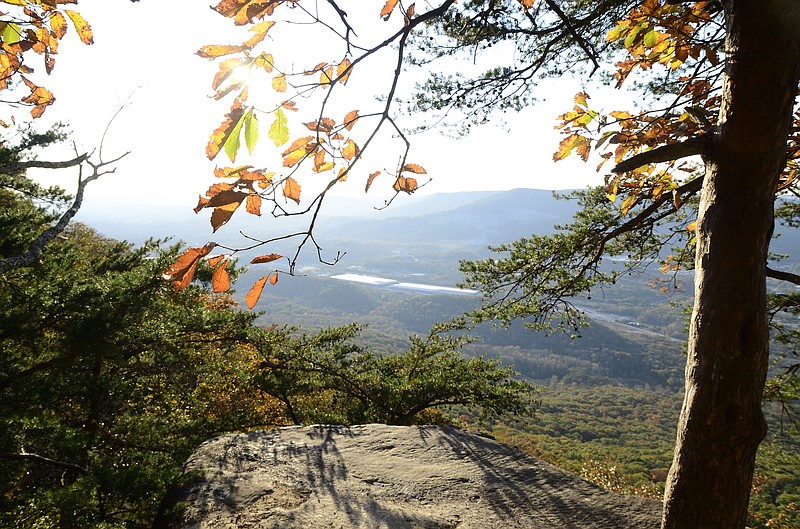Like politics, all climate is local, so let's get local. And let's get real. What will 2050 and beyond really look like on ordinary days here in the Chattanooga region?
When the climate warms 2 to 4 degrees Centigrade - or in America's lingo by about 4 to almost 6 degrees Fahrenheit - by the mid-century mark and later, our landscapes and our norms will change, according to a new interactive website at plus2c.org.
In the less-is-more scenario of just 4 degrees Fahrenheit, Chattanooga will feel a bit more like Centre, Alabama, 58 miles to our city's southwest: We will have 90 very warm (86 to 103 degree) days, up 12 from today's usual, and 53 freezing nights, a decrease of seven. There will be 45 days with extreme wildfire danger, an increase of four days from what we face now.
Take things up a notch to that upper end of almost 6 degrees warmer, and Chattanooga might as well be Hot Springs, Arkansas. And while Hot Springs National Park may be beautiful, its climate won't be for us.
Our city's late-century new normal will have 92 days - more than three months - to swelter. Today we usually have two-and- half-months of "very warm" summer. We'll also have almost two weeks fewer freezing nights- 57 instead of 46. And we'll have a whopping 76 days of extreme wildfire danger - up 35 days.
Things are only slightly different for our region.
The higher elevations will feel and be more like Lyerly, Georgia, near the Georgia/Alabama state line, 56 miles southwest of Walden, Tennessee. Instead of being Appalachian mixed mesophytic forests, the landscapes will change to Appalachian-Blue Ridge forests. The ridges and plateaus will see 28 additional very warm days, 10 fewer freezing nights and 13 mores days - 41 altogether - for extreme wildfire danger.
On the upper end of global warming predictions, the mountains will be more like Royal, Arkansas, 445 miles to the west, and the forests will change again - this time to something more like an Ozark Mountain forests ecoregion - assuming the woods haven't all burned to the ground in our whopping 92 days - up from 62 - of extreme wildfire danger.
All this is according to plus2c.org's analog atlas, developed by a team of scientists led by Solomon Dobrowski, a professor of landscape ecology at the University of Montana. The atlas is an interactive web page where you can search any location on the map to find its future climate match - or analog.
In a column on this page last week, Dobrowski explained that the atlas came about because of the need to explain the coming changes in a clearer way than the current vague description of "2-4 degrees Celsius warmer than today."
"I liken the challenge to describing a song to someone who has never heard it: 'It is in the key of C and has 4/4 timing,' he wrote. "The description is factually accurate but fails to inform" because it lacks context, emotion and framing.
In other words, we know what our landscape looks like today, and we know what our summers and winters feel like. Can we transport ourselves to other landscapes that look already like what we will look in 2050 and later?
With the atlas, we have a peek.
But be careful. It's addictive. Now that we know the more dire changes might make us look more like Royal and Hot Springs, Arkansas, what's going to happen in those locales?
Royal will look and feel more like De Queen, Arkansas, or Warren, Texas - depending on the degree of warming. It would change from an Ozark forest ecoregion to one of piney woods. And Hot Springs will come to be more like Broken Bow, Oklahoma, or Huntsville, Texas. Both Royal and Hot Springs will see still more very warm and hot weather. Hot Springs will have a whopping 33 fewer freezing nights and 60 more extreme fire danger days - meaning its wildfire fear will last about 4.5 months.
Ecoregion changes aren't new, we just weren't around to see them. That should be clear to anyone who's stood on an Appalachian stream bank and found a rock lying nearby with a fossilized imprint of palm bark. The difference is that we - people - not volcanoes or meteorites or some other natural phenomena - are driving this new change.
In a way that's good. It means that if we have the will, we can stop driving it so quickly and look for more sustainable ways to move ourselves around, power our homes and grow our food.
We're happy to note that Chattanooga and Tennessee have a front-row seat to the needed transportation change. Ford Motor Co. recently announced it will make the biggest investment Tennessee has ever seen to build electric-powered pickup trucks in Staton, and that's great. Yet Ford is a Johnny-come-lately to our electric vehicle scene. Nissan, Volkswagen, GM already are putting billions of dollars into Tennessee to build new electric cars and SUVs.
As for powering our homes and growing our food? We still have a long way to go.
In May, TVA CEO and President Jeff J. Lyash said he wants to decarbonize TVA by 2050, but he didn't explain how that will happen. What's more, by 2050, we're already on our way to becoming Hot Springs, Arkansas. TVA's timeline is too short and the utility continues to rely on false solutions like fracked gas while mostly ignoring non nuclear renewable energy.
And food? With the temperature changes described above, farmers have their work cut out for them. Stay tuned.
